13 start with W start with W
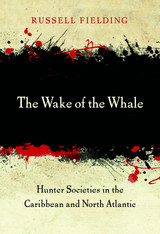
Despite declining stocks worldwide and increasing health risks, artisanal whaling remains a cultural practice tied to nature’s rhythms. The Wake of the Whale presents the art, history, and challenge of whaling in the Caribbean and North Atlantic, based on a decade of award-winning fieldwork.
Sightings of pilot whales in the frigid Nordic waters have drawn residents of the Faroe Islands to their boats and beaches for nearly a thousand years. Down in the tropics, around the islands of St. Vincent and the Grenadines, artisanal whaling is a younger trade, shaped by the legacies of slavery and colonialism but no less important to the local population. Each culture, Russell Fielding shows, has developed a distinct approach to whaling that preserves key traditions while adapting to threats of scarcity, the requirements of regulation, and a growing awareness of the humane treatment of animals.
Yet these strategies struggle to account for the risks of regularly eating meat contaminated with methylmercury and other environmental pollutants introduced from abroad. Fielding considers how these and other factors may change whaling cultures forever, perhaps even bringing an end to this way of life.
A rare mix of scientific and social insight, The Wake of the Whale raises compelling questions about the place of cultural traditions in the contemporary world and the sacrifices we must make for sustainability.
Publication of this book was supported, in part, by a grant from Furthermore: a program of the J. M. Kaplan Fund.
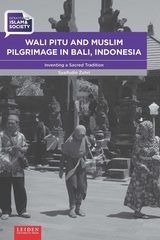

The most famous long-distance hiking trail in North America, the 2,181-mile Appalachian Trail—the longest hiking-only footpath in the world—runs along the Appalachian mountain range from Georgia to Maine. Every year about 2,000 individuals attempt to “thru-hike” the entire trail, a feat equivalent to hiking Mount Everest sixteen times. In Walking on the Wild Side, sociologist Kristi M. Fondren traces the stories of forty-six men and women who, for their own personal reasons, set out to conquer America’s most well known, and arguably most social, long-distance hiking trail.
In this fascinating in-depth study, Fondren shows how, once out on the trail, this unique subculture of hikers lives mostly in isolation, with their own way of acting, talking, and thinking; their own vocabulary; their own activities and interests; and their own conception of what is significant in life. They tend to be self-disciplined, have an unwavering trust in complete strangers, embrace a life of poverty, and reject modern-day institutions. The volume illuminates the intense social intimacy and bonding that forms among long-distance hikers as they collectively construct a long-distance hiker identity. Fondren describes how long-distance hikers develop a trail persona, underscoring how important a sense of place can be to our identity, and to our sense of who we are. Indeed, the author adds a new dimension to our understanding of the nature of identity in general.
Anyone who has hiked—or has ever dreamed of hiking—the Appalachian Trail will find this volume fascinating. Walking on the Wild Side captures a community for whom the trail is a sacred place, a place to which they have become attached, socially, emotionally, and spiritually.

A War that Can’t Be Won is the first book to include contributions from scholars on both sides of the US–Mexico border. It provides a unique breadth of perspective on the many dimensions of the societal crisis that affects residents of both nations—particularly those who live and work in the borderlands. It also proposes practical steps toward solving a crisis that shows no signs of abating under current policies. Each chapter is based on well-documented data, including previously unavailable evidence that was obtained through freedom-of-information inquiries in Mexico. By bringing together views from both sides of the border, as well as from various academic disciplines, this volume offers a much wider view of a complex problem—and possible solutions.

For his latest book, Venable has gathered and organized 139 of his newspaper columns—his biggest collection yet—to create a trove of wit and wisdom. In the spirit of “The Emperor’s New Clothes,” he points a finger at human nature, the environment, civil rights and wrongs, and an eclectic mix of other targets, drawing our attention to the foibles, failings, and just plain absurdities that surround us all.
As a native son and treasured institution in East Tennessee, Venable has earned the right to poke fun at its local history, habits, and happenings. He takes full, loving advantage of this license in essays such as “How to Tawlk Good,” “Shall We Gather with a Reptile,” and “The Good, the Bad, the Kudzu.” He takes on the government in a section titled “A Two-Ring Circus with Elephants and Donkeys,” and in another called “Still Waiting for Y2K,” he offers up “A Lesson in Dollars and Sense” and “Blowing the Budget for Bowser.”
Some have called him a modern-day Mark Twain, others the Dave Barry of Knoxville; but while there may be some similarities, Sam Venable is wonderfully unique. He sees—and sees through—the pervasive silliness and stupidity in our world. It evokes wonder in him, and with many a deft turn of phrase, he interprets that wonder for us. Warning! This Product Contains Nuttiness will make you smile, certainly, but it will also make you think and sometimes even touch your heart.
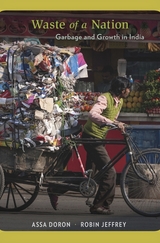
In India, you can still find the kabaadiwala, the rag-and-bone man. He wanders from house to house buying old newspapers, broken utensils, plastic bottles—anything for which he can get a little cash. This custom persists and recreates itself alongside the new economies and ecologies of consumer capitalism. Waste of a Nation offers an anthropological and historical account of India’s complex relationship with garbage.
Countries around the world struggle to achieve sustainable futures. Assa Doron and Robin Jeffrey argue that in India the removal of waste and efforts to reuse it also lay waste to the lives of human beings. At the bottom of the pyramid, people who work with waste are injured and stigmatized as they deal with sewage, toxic chemicals, and rotting garbage.
Terrifying events, such as atmospheric pollution and childhood stunting, that touch even the wealthy and powerful may lead to substantial changes in practices and attitudes toward sanitation. And innovative technology along with more effective local government may bring about limited improvements. But if a clean new India is to emerge as a model for other parts of the world, a “binding morality” that reaches beyond the current environmental crisis will be required. Empathy for marginalized underclasses—Dalits, poor Muslims, landless migrants—who live, almost invisibly, amid waste produced predominantly for the comfort of the better-off will be the critical element in India’s relationship with waste. Solutions will arise at the intersection of the traditional and the cutting edge, policy and practice, science and spirituality.
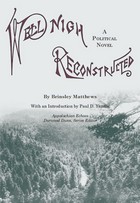
In 1882, William Simpson Pearson, writing under the pseudonym Brinsley Matthews, published Well-Nigh Reconstructed, a thinly disguised
autobiographical novel excoriating the enormous societal changes that had beset the former Confederacy during Reconstruction. Pearson’s work was especially notable in that the author was a onetime Radical Republican and supporter of Ulysses S. Grant’s bid for the presidency. A product of Pearson’s perception that northern Reconstruction policies had devastated his native North Carolina, the book set in motion a genre of politically motivated novels that would culminate near the turn of the twentieth century with Thomas Nelson Page’s Red Rock and later Thomas Dixon Jr.’s infamous The Clansman.
Though set in Virginia and Alabama, it is clear that Well-Nigh Reconstructed drew heavily on Pearson’s own experiences and that it was conceived as a direct response to A Fool’s Errand, a pro-Reconstruction novel by fellow North Carolinian Albion Tourgée. Echoing Pearson’s own disillusionment with the Radical Republicans, the novel’s protagonist, Archie Moran, comes to see Radical Reconstruction as an attempt to turn the South into a carbon copy of the North, and through a series of encounters involving corrupt carpetbaggers, greedy politicians, and the Klan trials of the late 1870s, Moran grows weary of politics altogether and resigns his Republican Party affiliation. For Pearson and
his doppelganger, Moran, Reconstruction became a vast breeding ground for corruption.
Featuring an extensive introduction by historian Paul D. Yandle, who sets the political and regional scene of Reconstruction North Carolina, this
reissue of Well-Nigh Reconstructed will shed new light on the ways in which sectionalism, regionalism, and the embrace of white supremacy tended to undermine the recently reconstituted Union among Appalachian residents.
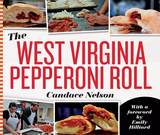
This spicy snack soon found its way out of the mines and into bakeries, bread companies, restaurants, and event venues around the state, often with additional ingredients like cheese, red sauce, or peppers.
As the pepperoni roll’s reputation moves beyond the borders of West Virginia, this food continues to embody the culinary culture of its home state. It is now found at the center of bake-offs, eating contests, festivals, as a gourmet item on local menus, and even on a bill in the state’s legislature.
The West Virginia Pepperoni Roll is a comprehensive history of the unofficial state food of West Virginia. With over 100 photographs and countless recipes and recollections, it tells the story of the immigrants, business owners, laborers, and citizens who have developed and devoured this simple yet practical food since its invention.
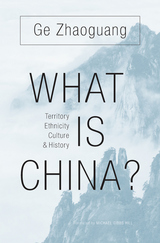
Ge Zhaoguang, an eminent historian of traditional China and a public intellectual, takes on fundamental questions that shape the domestic and international politics of the world’s most populous country and its second largest economy. What Is China? offers an insider’s account that addresses sensitive problems of Chinese identity and shows how modern scholarship about China—whether conducted in China, East Asia, or the West—has attempted to make sense of the country’s shifting territorial boundaries and its diversity of ethnic groups and cultures.
Ge considers, for example, the ancient concept of tianxia, or All-Under-Heaven, which assigned supremacy to the imperial court and lesser status to officials, citizens, tributary states, and tribal peoples. Does China’s government still operate with a belief in divine rule of All-Under-Heaven, or has it taken a different view of other actors, inside and outside its current borders? Responding both to Western theories of the nation-state and to Chinese intellectuals eager to promote “national learning,” Ge offers an insightful and erudite account of how China sees its place in the world. As he wrestles with complex historical and cultural forces guiding the inner workings of an often misunderstood nation, Ge also teases out many nuances of China’s encounter with the contemporary world, using China’s past to explain aspects of its present and to provide insight into various paths the nation might follow as the twenty-first century unfolds.
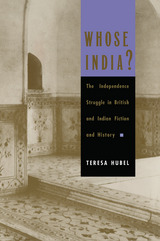
Hubel collapses the boundary between literature and history by emphasizing the selected nature of the “facts” that comprise historical texts, and by demonstrating the historicity of fiction. In analyzing the orthodox construction of the British/Indian encounter, Hubel calls into question assumptions about the end of nationalism implicit in mainstream histories and fiction, which generally describe a battleground on which only ruling-class Indians and British meet. Marginalized texts by women, untouchables, and overt imperialists alike are, therefore, examined alongside the well-known work of figures such as Rudyard Kipling, Jawaharlal Nehru, E. M. Forster, and Mahatma Gandhi.
In Whose India? discursive ownership and resistance to ownership are mutually constructing categories. As a result, the account of Indian nationalism and British imperialism that emerges is much more complicated, multivocal, and even more contradictory than previous studies have imagined. Of interest to students and scholars engaged in literary, historical, colonial/postcolonial, subaltern, and Indian studies, Whose India? will also attract readers concerned with gender issues and the canonization of texts.
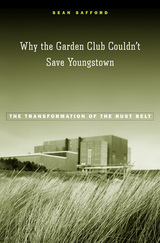
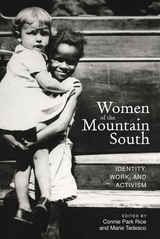
Scholars of southern Appalachia have largely focused their research on men, particularly white men. While there have been a few important studies of Appalachian women, no one book has offered a broad overview across time and place. With this collection, editors Connie Park Rice and Marie Tedesco redress this imbalance, telling the stories of these women and calling attention to the varied backgrounds of those who call the mountains home.
The essays of Women of the Mountain South debunk the entrenched stereotype of Appalachian women as poor and white, and shine a long-overdue spotlight on women too often neglected in the history of the region. Each author focuses on a particular individual or group, but together they illustrate the diversity of women who live in the region and the depth of their life experiences. The Mountain South has been home to Native American, African American, Latina, and white women, both rich and poor. Civil rights and gay rights advocates, environmental and labor activists, prostitutes, and coal miners—all have lived in the place called the Mountain South and enriched its history and culture.
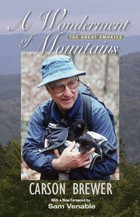
“Carson Brewer at his absolute best.” – Sam Venable
Carson Brewer on…
Mountain places
Snow was nice and crunchy underfoot. Not crunchy like peanuts or cornflakes. Rather, it was a silky whispery crunchy.
Mountain plants
You can bury your nose deep in the cool violet bed and smell the mix of life and death while pondering the unceasing cycle of each into the other.
Mountain People
Lem Ownby…has plowed oxen, mules, and horses on the forty-four acre farm on Jakes Creek. But he has never owned or driven an automobile.
The Author: Carson Brewer was a reporter and columnist for more than forty years. His columns on conservation issues and on the Great Smoky Mountains earned him the E.J. Meeman Conservation Award (twice) from the Scripps-Howard Foundation, the Golden Press Card award from the Society of Professional Journalists (which also named a scholarship in his honor in 1984), and the inaugural Lifetime Achievement Award from the Knoxville Writers Guild. He died on January 15, 2003.
READERS
Browse our collection.
PUBLISHERS
See BiblioVault's publisher services.
STUDENT SERVICES
Files for college accessibility offices.
UChicago Accessibility Resources
home | accessibility | search | about | contact us
BiblioVault ® 2001 - 2024
The University of Chicago Press









